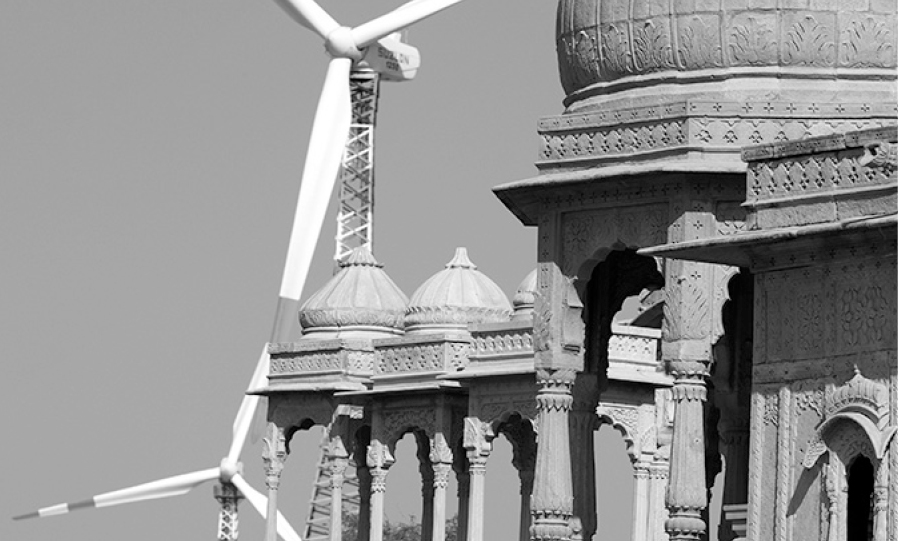

Rajasthan was an early mover in India’s renewable energy space. Among the states, it accounts for the fifth highest installed capacity after Gujarat, Karnataka, Tamil Nadu and Maharashtra. Renewable energy forms 43.5 per cent of Rajasthan’s installed capacity, as of March 2020. However, the state has faced several challenges such as the unavailability of transmission infrastructure and land shortage. It remains hopeful that it will be able to overcome these barriers going forward. During his address at the 3rd Virtual RE-INVEST Conference 2020, Subodh Agarwal, chairman and managing director, Rajasthan Renewable Energy Corporation Limited (RRECL), called upon developers and manufacturers from across the globe to invest in the state’s green energy sector and contribute to its growth. He drew attention to the policy changes and transmission infrastructure that the government is developing to give a fillip to renewable energy development in the state. Excerpts from his remarks…
Rajasthan is known as the sunny state of India as we have the highest solar irradiation among all states in the country. In terms of wind potential, we are second in the country in terms of installed capacity. The state has set out its policies and programmes to attract developers and boost renewable energy deployment in the state. According to a recent survey by the Ministry of New and Renewable Energy (MNRE), 125,000 hectares of land has been used in Rajasthan for renewable energy. What is interesting is that this land is distributed across only three districts, Bikaner, Jodhpur and Jaisalmer. The land in Rajasthan, especially in these three districts, has never been suitable for agriculture as it is a desert. Now, we feel that it is a natural advantage as low opportunity costs have attracted developers to the state.
The state has implemented new policies like the Rajasthan Investment Promotion Scheme (RIPS), 2019, which is unique in many ways. To formulate this policy, we compared the schemes of various states and offered the best possible concessions for investors. We have also established a single-window system, wherein all 14 bodies (soon to be 21) of the state energy portal will be integrated to form one forum. This will ensure that clearances and permits are granted efficiently. The solar energy policy and the solar-wind hybrid policy go beyond RIPS and offer even more concessions and incentives.
From an infrastructure standpoint, we have built a strong power evacuation system. RRECL has the capacity to develop the state transmission infrastructure for 6 GW of electricity. In addition, Power Grid Corporation of India Limited is developing a 20 GW central transmission system from Bantva in Gujarat to Moga in Punjab with the majority of the system passing through Rajasthan. It is commonly believed that Rajasthan has low water supply. However, for renewable energy developers, the water department has given them the guarantee of 25 cusecs of water through the Indira Gandhi Canal.
Capacity development
Rajasthan boasts of the highest solar radiation in the country at 5.72 kWh per square metre per day. Developers believe that a solar plant set up in Rajasthan will offer 10-15 per cent higher energy than those set up in other states. The Solar Energy Corporation of India’s latest auction in Rajasthan has seen a record low tariff of Rs 2 per kWh. The MNRE is optimistic that this tariff could go down to Rs 1.50 per kWh or even lower in the following years. If you analyse the trends, Rajasthan has offered the lowest tariffs due to its natural advantage of having 325 sunny days in a year.
In the wind energy segment, we have a capacity of 127 GW. As per a recent report by the National Institute of Wind Energy, Rajasthan has the second highest wind energy potential in the country, after Gujarat, with the estimated capacity utilisation factor (CUF) in selected areas ranging from 18 per cent to 35 per cent. We are not too far behind Gujarat in terms of wind potential. If Gujarat reports a CUF of 20 per cent, Rajasthan will have a CUF of 18 per cent for identical capacities. For wind development in the future, we have identified the tribal areas of Banswara and Pratapgarh in the southern part of the state. The areas near Jaisalmer and Barmer, close to the Pakistan border, also have great wind energy potential.
“From an infrastructure standpoint, we have built a strong power evacuation system.”
Policy framework
Even when it comes to inland deposits of oil and gas, we have the highest in the country. I reiterate that the desert, which used to be perceived as our weakness, is now our biggest strength. We strongly believe that Rajasthan’s deserts have become its biggest asset as the state strives to become a world leader in renewable energy deployment. Around 125,000 hectares of land has already been identified across three districts, Jaisalmer, Jodhpur and Bikaner. Several other districts are yet to be surveyed. The state has been able to offer low reserve prices on government land, and thus attract developer interest. The state has also drafted the Renewable Energy Rules, 2007, which specify that there is no land ceiling for renewable energy development. This is aimed at making Rajasthan a one-stop shop for renewable energy projects. We have also drafted an act which states that if a micro, small and medium (MSME) proposes to install renewable energy capacities, it will not need any permissions or clearances. Further, their operations will not be inspected for the first three years.
Under the RIPS policy, we offer 100 per cent exemption on stamp duty and land tax. The policy also assures a 75 per cent investment subsidy on State Goods and Services Tax and a 50 per cent subsidy on employment contributions like ESI and EPF for seven years. The subsidies are even higher for manufacturing units. These include land allotment at 50 per cent concessional rates, 100 per cent exemption on electricity duty for 10 years, and an additional 40 per cent employment subsidy. Manufacturers are also entitled to certain interest subsidies, capital subsidies and benefits that are usually reserved for MSMEs.
Under the Solar, Wind and Hybrid Policy, RRECL, in November 2020, announced an exemption of transmission and wheeling charges for 500 MW or more of renewable capacity. Further, the policy offers a 75 per cent exemption for seven years for storage systems, and 100 per cent exemption for 10 years for renewable energy-powered charging stations. The policy also offers an annual banking facility and 100 per cent exemption on electricity duty for captive consumption for captive projects. We can confidently say that Rajasthan offers the highest benefits for renewable energy among all states in the country.
“Despite the state’s renewables mix being dominated by wind and solar capacities, we have witnessed a steady increase in the number of biomass projects.”
The state also offers customised packages for investors that invest in large-scale renewable energy projects. Players such as Adani, Greenko and ReNew Power have come up with proposals for these packages. Adani has proposed 8,000 MW of solar projects along with 1,700 MW of hybrid projects while Greenko has proposed a 5,000 MW wind-solar hybrid project. ReNew power aims to enter the manufacturing space by setting up a solar module and cell manufacturing unit with a production capacity of 1,400-2,000 MW. The total investment through these proposed projects is estimated at Rs 770 billion.
We are pleased to announce that the Bhadla Solar Park is now commissioned with an installed capacity of 2,245 MW. In addition, there are other solar parks under execution. These include parks in Phalodi-Pokaran (750 MW), Fatehgarh (1,500 MW) and Nokh (925 MW). These parks cannot possibly accommodate more capacities as the lands have been used to their full potential. Hence, we have identified about 50,000 hectares of land for future renewable energy development in the Jaisalmer area. We could potentially install the biggest solar park in the world on this land. As of today, the state has an installed renewable capacity of 10,010 MW, while 2,303 MW is under development. Further, over 11,157 MW of projects are currently under consideration by the government.
Despite the state’s renewables mix being dominated by wind and solar capacities, we have witnessed a steady increase in the number of biomass projects with 18 MW under development and 157 MW under consideration. We had set a target of 30 GW of solar, 4 GW of wind and 3.5 GW of hybrid capacities by 2024-25. We expect that the chief minister will revise this target soon as we have already committed to 2.7 GW of capacity. There is also an unfulfilled renewable capacity of 5,511 MW, which we aim to fulfil in the coming years. Our growth partners include the likes of Vestas, the largest wind turbine manufacturing company in the world, Siemens Gamesa and Suzlon. We have also developed several projects in collaboration with NTPC Limited, NHPC Limited, Tata Power, Adani Solar and even SB Energy.
We invite more developers to improve the state’s renewable capacity and request them to improve the manufacturing capacity as well. We hope that we can together develop Rajasthan and India.


